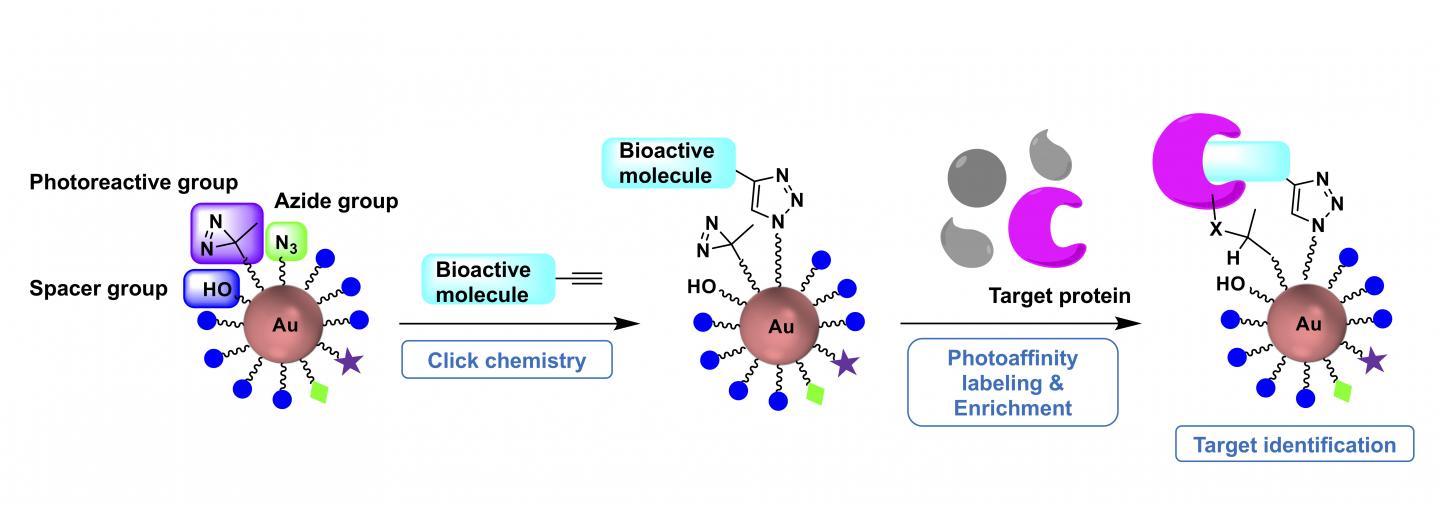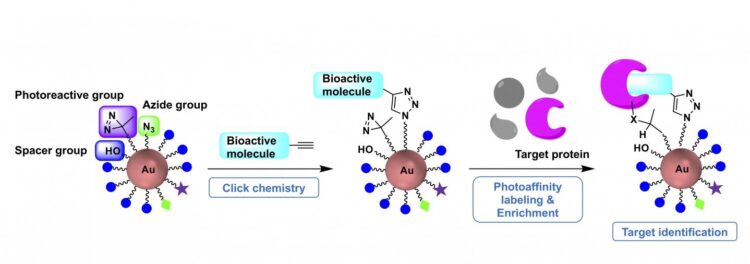
Credit: FIGURE MODIFIED FROM Organic and Biomolecular Chemistry, January 2021, DOI:
10.1039/D0OB01688H
The development of pharmaceutical treatments is difficult — clinicians and researchers know a certain drug can regulate particular functions, but they might not know how it actually works. Researchers at Tokyo University of Agriculture and Technology (TUAT) have developed a new, streamlined method to better understand the molecular mechanisms underpinning these interactions.
They published their approach on Dec. 17, 2020 in Organic & Biomolecular Chemistry, a journal of the U.K. Royal Society of Chemistry.
“We set out to develop a new gold nanoparticle-based method for target identification of bioactive small molecules that streamlines the current laborious steps so that we can rapidly find out how these molecules work,” said Kaori Sakurai, associate professor in the Department of Biotechnology and Life Science at TUAT.
Bioactive small molecules are chemical compounds, such as pharmaceuticals, that can be readily delivered to and interact with a body’s cells. By binding to specific proteins, these molecules can rewire a biological process to stop or enhance whatever the initial function was. For example, the bioactive small molecules in an anticancer agent will bind with a protein in cancer cells to inhibit their uncontrolled growth. They can even to trick the cancer cells into programmed cell death.
The challenge is that it’s not always clear which proteins are being targeted or whether there are other proteins targeted that may potentially cause unwanted side effects. Using a technology called photoaffinity labeling, researchers can shine light on target proteins and instantaneously tag them, capturing and identifying them. However, photoaffinity labeling requires extensive time and resources to develop the specific tag, ensure it is attached to the right target in the cell and then purify the tagged target protein.
“Photoaffinity labeling is a powerful approach for the discovery of small molecule-target proteins,” Sakurai said. “However, its routine use has been hampered by several issues, including inefficient protein labeling and subsequent purification and technical difficulties of making bioactive small molecules into suitable probes.”
Sakurai’s team previously provided a solution to the first issue by employing a gold nanoparticle as modular scaffolding on which a specific probe can be designed. In the recent paper, they focused on developing a one-step preparation process.
Since gold nanoparticles have surfaces that can hold modular pieces, the researchers can efficiently build customized assemblies by simply mixing building blocks, according to paper co-author Kanna Mori, a graduate student in the Department of Biotechnology and Life Science at TUAT.
“Photoaffinity probes can be easily obtained from the probe precursors, preassembled with three types of building blocks — each containing a clickable group, a photoreactive group and a water-soluble spacer group–and then rapidly incorporate a small-molecule of interest through ‘click chemistry,'” Mori said.
The fabricated small molecule, even after being conjugated to the nanoparticle, behaves as a parent molecule that would naturally bind to a protein, and the photoreactive group reacts to ultraviolet light irradiation that activates the probe. Once activated, the probe can capture and isolate a target protein.
“We demonstrated that clickable photoaffinity probe precursors will provide a rapid access to photoaffinity probes of different types of bioactive small molecules to identify their target proteins,” Sakurai said.
Next, the researchers plan to explore the utility of gold-nanoparticle probes in target identification studies in live cells, expanding their work to factor in physiological conditions. They also plan to introduce complex natural products and some pharmaceuticals into the gold-nanoparticles to begin identifying their unknown target proteins.
###
The Japan Society for the Promotion of Science supported this work.
For more information about the Sakurai laboratory, please visit http://web.
Original publication:
Clickable gold-nanoparticles as generic probe precursors for facile photoaffinity labeling application. Kanna Mori and Kaori Sakurai. Organic & Biomolecular Chemistry, 2021
https:/
About Tokyo University of Agriculture and Technology (TUAT):
TUAT is a distinguished university in Japan dedicated to science and technology. TUAT focuses on agriculture and engineering that form the foundation of industry, and promotes education and research fields that incorporate them. Boasting a history of over 140 years since our founding in 1874, TUAT continues to boldly take on new challenges and steadily promote fields. With high ethics, TUAT fulfills social responsibility in the capacity of transmitting science and technology information towards the construction of a sustainable society where both human beings and nature can thrive in a symbiotic relationship. For more information, please visit http://www.
Contact:
Kaori Sakurai, Ph.D.
Associate Professor
Department of Biotechnology and Life Science
Tokyo University of Agriculture and Technology (TUAT), Japan
Media Contact
Yutaka Nibu, Ph.D.
[email protected]
Related Journal Article
http://dx.





